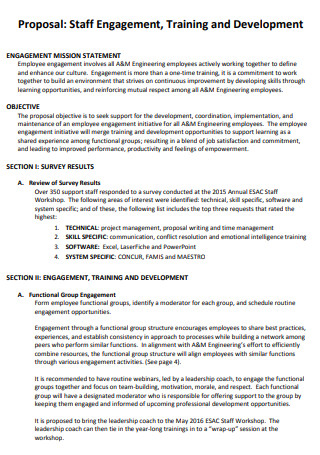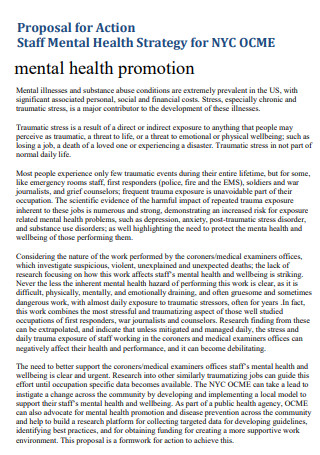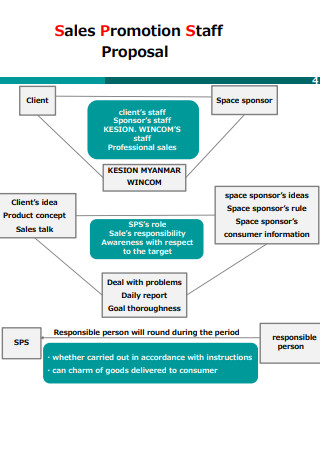3+ SAMPLE Staff Promotion Proposal
FREE Staff Promotion Proposal s to Download
3+ SAMPLE Staff Promotion Proposal
What Is a Staff Promotion Proposal?
Benefits of Staff Promotion
Foundational Traits To Be Promoted
Tips To Get Promoted
How To Write a Staff Promotion Proposal
FAQs
What is a promotion proposal?
What is promotion of an employee?
How is a company promoted?
What Is a Staff Promotion Proposal?
Numerous elements, such as a job position opening, the employee’s abilities and capabilities to complete the task before or on the deadline, being a team member, contributing a significant portion of the company’s profit, and many more, could accelerate an employee’s career progression. And this might serve as the basis for your staff promotion proposal, should you create one. This proposal is a written document that endorses a candidate for a specific job or post. It contains the employee’s future designation, the wage increase, the cause for their professional advancement, and other pertinent information. According to statistics, 8.9% of employees were promoted, while 30.2% were newly hired.
Benefits of Staff Promotion
This component will undoubtedly come up if you ask any employee what inspires them. Progress is inherent to the human condition, and your employees are no different. Keeping this in mind, let’s discuss the various aspects of employee promotion in the workplace. Employee promotion refers to an employee’s ascent to higher levels. It entails increasing compensation, position, duties, standing, and perks. This component of the job motivates employees the most; it is the greatest reward for an organization’s dedication and loyalty. This section will highlight the advantages of being promoted.
Foundational Traits To Be Promoted
Solid core characteristics suggest suitability for various vocations and, ultimately, a leadership position. As an employer or manager, you must see past the phrase “she’s a good worker” and recognize the qualities that will translate effectively into the promoted role.
Tips To Get Promoted
Many of us were likely raised to let our efforts “speak for ourselves.” Unfortunately, when seeking a promotion, that may not be sufficient. While “corporate ladder climbers” have a negative connotation, there is nothing wrong with seeking recognition for your accomplishments. Being a member of the organization is a crucial first step if you have your sights set on a promotion or a higher income in the future. But if you genuinely want to distinguish yourself as a future leader, here are several actions you may take to learn how to advance in your career.
1. Make your employer’s job easier
Since you’ve been in your job for a while, you probably know what your boss is most worried about. Taking care of their worries can make them think of you as reliable and capable. It shows that you are part of a team and care about the bigger picture. Try taking on some of their work while they’re away so they can relax and enjoy their time off.
2. Develop your communication abilities
Promotion typically entails assuming a leadership position. Remember, the greater your responsibilities, the greater the importance of your communication skills. Invest some time in studying how to communicate with various types of individuals. Learning how to be promoted goes hand in hand with learning how to communicate. Investing in these relationships today will ease the transition should you become their supervisor in the future.
3. Consider ways to improve and be nice
To demonstrate to your superiors that you are qualified for a promotion, you must be performing exceptionally well in your current role. However, this does not imply that there is no space for improvement. Ask how you can grow better. Take the time to acquire new abilities and practice receiving feedback like a manager. Accepting constructive criticism without becoming defensive will demonstrate that you are prepared for the next level. Also, cultivate solid ties within your organization. The decision to promote an employee requires the input of others for most managers. Maintaining positive relationships can motivate coworkers to advocate for you when it matters. Always show everyone courtesy and respect.
4. Acknowledge others
Your advancement isn’t just about you. Those who can encourage and lead successful teams get promoted. If you attempt to advance your career, you might be inclined to shout your self praises. However, by acknowledging others, you will enhance your reputation. Who knows, perhaps the employee you call out will return the favor.
5. Communicate with your employer
Do not be scared to express your desire for a promotion to your management. They can assist you in developing core talents and keep you in mind for future upgrades. You are not required to begin the conversation by requesting a promotion. Instead, ask what is needed to obtain one. This will present your boss as a guide or mentor and make them equally committed to your professional success.
6. Pay close attention to those who have received promotions and be resilient
Has anyone else been recently promoted? Ask how they accomplished it. Over time, did they take on additional tasks, return to school, or assume a newly formed position? Consider how you may benefit from their experience. Ask if they have any suggestions or feedback for you. Also, when your promotion arrives, it is time to celebrate, but it may also bring tension. Leaders get incredible “stage time,” but they also have to deal with more people and significant stakes. Develop resilience immediately by enhancing your stress management skills and work-life balance. These “soft” leadership abilities will pay off as you rise to higher levels.
7. Create value anywhere possible.
Numerous individuals believe that dominating every conversation is a leadership quality. Be deliberate in your speech so that you are known for providing only valuable input. Consider ways to streamline procedures to be more productive. Invest the time you’ve gained in enhancing your skillset or completing initiatives that merit your entire focus.
How To Write a Staff Promotion Proposal
Promotions are an effective method of rewarding employees for their hard work within the organization. They improve employee engagement and motivate teams to achieve excellence. If you are working with an individual, you believe merits a promotion, the simplest method to begin is to draft a proposal to promote the employee. Employees will appreciate your assistance if they are a subordinate or a colleague.
1. Determine Your Company’s Plans
Before preparing your promotion proposal letter, investigate your organization’s organizational structure and future goals. It would help if you determined whether a promotion inside the organization is feasible today or shortly. Does the company have an open ad for this new position, or would they consider it in the future? If this person is promoted, will you need to find a replacement for their current work? Knowing this information will help you draft a more effective promotion proposal letter. How you position the individual will depend on whether the promotion is available immediately or if it may occur many months from now. Knowing whether other individuals may be applying for this post is vital.
2. Collect the Facts
After determining your company’s staffing strategy, you will need to collect information in your proposal to promote an employee. The first step is to identify the decision-maker. This is the individual to whom you will address the letter. They may be the head of your company’s human resources department or another executive. You must have measures that demonstrate the employee’s impact on the organization. For instance, what projects have they recently worked on? For example, are his three-year sales results available if he is a salesperson? What was the return on investment for his previous three marketing initiatives, assuming he works in marketing? This information will help demonstrate this employee’s worth to the organization.
3. Consider the Employee’s Abilities and Accomplishments.
In addition to measurements, you will need specific reasons why this individual is now qualified for a promotion. Do you recall any instances where he went above and beyond his duties? How has he demonstrated leadership within the company? Does he already do tasks that are typically reserved for more senior positions? A history of the employee’s leadership abilities and development helps demonstrate his readiness for promotion.
4. Create Your Proposal for an Employee Promotion
Start your promotional activity proposal by formally addressing the decision-maker. Follow the recipient’s name with a salutation such as “To” or “Dear.” The first paragraph of your letter should state its purpose. Inform the letter’s receiver that you are proposing an employee’s promotion. Document your relationship. If there is an open promotion position, specify it; otherwise, mention that you would like the employee to be considered for future promotions. Discuss the measures demonstrating the employee’s contribution to the company’s growth in the next paragraph. Introduce the metrics by discussing the employee’s strengths. Finally, discuss the employee’s promotion readiness. Provide instances demonstrating why this individual is qualified for a position with increased organizational responsibilities.
5. Follow Up With a Meeting
You don’t want a suggestion to promote an employee to get lost in the flow of day-to-day activities. A few days after sending your proposal to the decision-maker, schedule a short meeting with them to confirm that they have received it. Offer to answer any additional questions regarding the employee or the information you gave.
FAQs
What is a promotion proposal?
A promotional plan includes a comprehensive strategy for promoting your business or selling a specific product. When writing your promotional plan, you must consider various elements, including funding limits, prior sales, and intended outcomes.
What is promotion of an employee?
A promotion is an acknowledgment of an employee’s commitment to your organization. Promotions of employees can take numerous forms but often involve a combination of the following: Increased pay. Higher-ranking job title. Additional and elevated responsibility.
How is a company promoted?
It begins with an individual or group of individuals conceiving a potential future business opportunity and then taking the initiative to give it a practical form by founding a company. These individuals or groups who go on to start a firm are known as promoters of the company.
Staff promotions inside the organization stimulate an employee’s growth and professional development; this also motivates them to give their best performance, resulting in an improved outlook for the company’s productivity. Therefore, if you believe it is time for your employee to be promoted, begin drafting your staff promotion proposal and assist them in obtaining the desired promotion.




